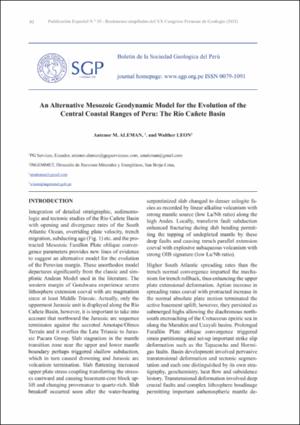- Repositorio Institucional INGEMMET
- Ponencias y Artículos científicos
- Ponencias, comunicaciones en congresos
Please use this identifier to cite or link to this item:
https://hdl.handle.net/20.500.12544/4317An alternative Mesozoic geodynamic model for the evolution of the Central Coastal ranges of Peru: the Rio Cañete Basin
Nov-2021
XX Congreso Peruano de Geología “Geología y desarrollo en nuestro Bicentenario”, Lima, Perú, 11-15 octubre 2021. Resúmenes extendidos. Publicación Especial, n° 15.
Integration of detailed stratigraphic, sedimentologic and tectonic studies of the Río Cañete Basin with opening and divergence rates of the South Atlantic Ocean, overriding plate velocity, trench migration, subducting age (Fig. 1) etc. and the protracted Mesozoic Farallon Plate oblique convergence parameters provide new lines of evidence to suggest an alternative model for the evolution of the Peruvian margin. These unorthodox model departures significantly from the classic and simplistic Andean Model used in the literature. The western margin of Gondwana experience severe lithosphere extension coeval with arc magmatism since at least Middle Triassic. Actually, only the uppermost Jurassic unit is displayed along the Río Cañete Basin, however, it is important to take into account that northward the Jurassic arc sequence terminates against the accreted Amotape/Olmos Terrain and it overlies the Late Triassic to Jurassic Pucara Group. Slab stagnation in the mantle transition zone near the upper and lower mantle boundary perhaps triggered shallow subduction, which in turn caused drowning and Jurassic arc volcanism termination. Slab flattening increased upper plate stress coupling transferring the stresses eastward and causing basement-core block uplift and changing provenance to quartz-rich. Slab breakoff occurred soon after the water-bearing serpentinized slab changed to denser eclogite facies as recorded by linear alkaline volcanism with strong mantle source (low La/Nb ratio) along the high Andes. Locally, transform fault subduction enhanced fracturing during slab bending permitting the tapping of undepleted mantle by these deep faults and causing trench parallel extension coeval with explosive subaqueous volcanism with strong OIB signature (low La/Nb ratio). Higher South Atlantic spreading rates than the trench normal convergence imparted the mechanism for trench rollback, thus enhancing the upper plate extensional deformation. Aptian increase in spreading rates coeval with protracted increase in the normal absolute plate motion terminated the active basement uplift; however, they persisted as submerged highs allowing the diachronous northsouth encroaching of the Cretaceous epeiric sea in along the Marañón and Ucayali basins. Prolonged Farallón Plate oblique convergence triggered strain partitioning and set-up important strike slip deformation such as the Tapacocha and Hormigas faults. Basin development involved pervasive transtensional deformation and tectonic segmentation and each one distinguished by its own stratigraphy, geochemistry, heat flow and subsidence history. Transtensional deformation involved deep crustal faults and complex lithosphere boudinage permitting important asthenospheric mantle de- compression melting magmatism that mixed with partially metasomatized subduction slab as documented by relative low La/Yb and La/Nb ratios and the occurrence of Nb-Ta negative anomalies. Two distinctive magmatic regimes are separated by an important and major plutonic regime linked to the emplacement of the Peruvian Costal Batholith (PCB) encompassing episodic multi-scale stopping, caldron subsidence and assimilation. The oldest volcanic regime (Casma Group), has higher mantle contribution and insignificant crustal contamination compare to the younger one (Quilmaná Formation). However, locally detrital zircons (DZ) and Hf isotopes support the presence of juvenile zircons supporting the absence of crustal contamination.
Sociedad Geológica del Perú - SGP
Aleman, A. & León, W. (2021). An alternative Mesozoic geodynamic model for the evolution of the Central Coastal ranges of Peru: the Rio Cañete Basin. En: Congreso Peruano de Geología, 20, Lima, 2021. Resúmenes extendidos. Lima: Sociedad Geológica del Perú, pp. 82-89.
8 páginas
Files in This Item:
| File | Description | Size | Format | |
|---|---|---|---|---|
| Aleman-An_alternative_Mesozoic_Rio_Cañete_basin.pdf | Artículo de congreso | 511.72 kB | Adobe PDF | View/Open |
This item is licensed under a Creative Commons License












